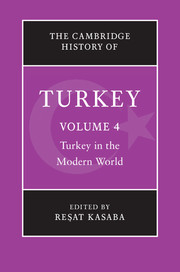Book contents
- Frontmatter
- 1 Introduction
- PART I OTTOMAN BACKGROUND AND TRANSITION
- PART II REPUBLIC OF TURKEY
- 7 Migration and Turkey: the dynamics of state, society and politics
- 8 The migration story of Turks in Germany: from the beginning to the end
- 9 Politics and political parties in Republican Turkey
- 10 Economic change in twentieth-century Turkey: is the glass more than half full?
- 11 Ideology, context and interest: the Turkish military
- 12 Kurds and the Turkish State
- 13 Islam and politics in contemporary Turkey
- 14 Sufism and Islamic groups in contemporary Turkey
- 15 Contestation and collaboration: women’s struggles for empowerment in Turkey
- 16 Art and architecture in modern Turkey: the Republican period
- 17 The novel in Turkish: narrative tradition to Nobel prize
- 18 A brief history of modern Istanbul
- Select bibliography
- Index
- References
18 - A brief history of modern Istanbul
from PART II - REPUBLIC OF TURKEY
Published online by Cambridge University Press: 28 November 2009
- Frontmatter
- 1 Introduction
- PART I OTTOMAN BACKGROUND AND TRANSITION
- PART II REPUBLIC OF TURKEY
- 7 Migration and Turkey: the dynamics of state, society and politics
- 8 The migration story of Turks in Germany: from the beginning to the end
- 9 Politics and political parties in Republican Turkey
- 10 Economic change in twentieth-century Turkey: is the glass more than half full?
- 11 Ideology, context and interest: the Turkish military
- 12 Kurds and the Turkish State
- 13 Islam and politics in contemporary Turkey
- 14 Sufism and Islamic groups in contemporary Turkey
- 15 Contestation and collaboration: women’s struggles for empowerment in Turkey
- 16 Art and architecture in modern Turkey: the Republican period
- 17 The novel in Turkish: narrative tradition to Nobel prize
- 18 A brief history of modern Istanbul
- Select bibliography
- Index
- References
Summary
Nationalising the imperial capital
The history of modern Istanbul, like the history of modern Turkey, begins with the end of the First World War and the demise of the Ottoman Empire. The city that became Istanbul was, famously, established as an imperial capital – the new Rome that would take over the functions of the seat of empire from the decrepit old Rome. The geography of the seas and continents surrounding the city made it a natural focus, which in the longue durée would assert itself as the centre of networks whose nature and relative weight changed in time, but whose topographies exhibited continuity. Over the thousand years of its Byzantine incarnation the city’s fortunes waxed and waned, until it was reduced to a dependency of Genoa after the ravages imposed by the Latins during the Fourth Crusade (1204–61). The Ottoman dynasty revived Istanbul’s centrality to the larger Eurasian region and helped resuscitate its economy, not only as a trading post, but also as a centre of what we would today call cultural industries – education, books, the higher arts and exclusive items of consumption for the wealthy. The city’s size soon came to dwarf any competitor in the entire Middle East and the Balkans; its imperial riches and the consumption capacity of its inhabitants made it into the largest marketplace in that region.
- Type
- Chapter
- Information
- The Cambridge History of Turkey , pp. 504 - 523Publisher: Cambridge University PressPrint publication year: 2008
References
- 12
- Cited by



